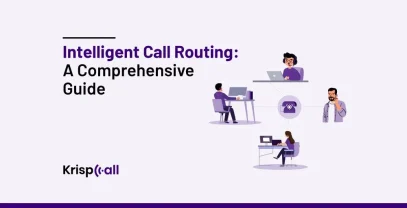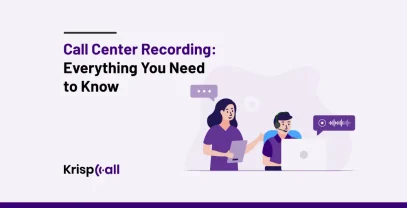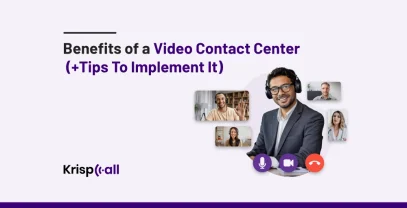Are you looking for a way to track your call outcomes by leveraging your daily phone calls into different categories? Or are you having trouble arranging countless call center phone calls❓
In this case, call disposition can simplify your workload by categorizing your call outcomes under different tags. Get easy logging for the outcome of the calls by labeling each call outcome to a particular category and analyzing those outcomes to enhance your business.
In this guide, we’ll delve into what call disposition is, why it’s important for your business, and how you can leverage it to enhance your communication strategies.
🚀Key Highlights
- The call disposition process involves categorizing every call into different steps, such as identifying the call outcome, selecting the call disposition code, recording information, capturing data, and finally analyzing and reporting it.
- Call deposition offers a variety of benefits to call centers that help to understand customer needs, enhance sales performance, allocate resources, make data-driven decisions, track performance, and manage risk.
- Some of the frequent and important types of call dispositions are sales, technical support, customer complaints, setting appointments, leaving voicemails, call transferring, no answer, wrong number, do not call, a survey completed, and more.
- The 5 best practices for assigning call disposition codes are clear & standardized disposition codes, keeping a limited number of disposition codes, regular review & follow-up, integrating with customer feedback, and proper training to your agent.
- There are 4 major use cases for call disposition which are contact center & call center, marketing & sales, reporting & analysis, and identifying upselling opportunities.
- KrispCall is one of the best options for categorizing your calls & contacts as it provides features such as call & contact tagging, call notes, call analytics, and many more.
What is a call disposition?
A call disposition is simply a label or code used to describe the outcome of a call. It is used in call centers and contact centers to track the purpose of a call and classify what happened during the call.

It is a valuable piece of data that adds depth to the call by summarizing the interaction and aiding in tracking outcomes like completed sales, resolved technical issues, or lodged customer complaints. It also enables the analysis of trends and patterns in customer interactions by categorizing calls.
How does call disposition work?
To understand how call disposition actually works, you need to relate to the agent. Once you start making calls and go through a call campaign you need to keep track of every call and its outcome.
After every call ends, you need to address several questions. Where did the lead come from? Did the customer express interest or disinterest? Do we need to follow up? Was the wrong number dialed, or did you receive no response?
Call disposition works by categorizing the outcome or result of customer interaction with a call center agent. Here’s the typical process:
- During the Call: When a customer contacts a call center, the system routes the call to an available agent, who then addresses the customer’s inquiry, issue, or request according to established scripts, protocols, or guidelines.
- Outcome Identification: At the end of the call, the agent categorizes how the interaction went using predetermined call disposition codes or categories. They usually pick these codes from a dropdown menu or input them manually into the call center software system.
- Selecting call disposition codes: The agent picks the most fitting disposition code depending on the call’s nature and whether it’s resolved. For instance, they might opt for “Resolved” if the problem got fixed, “Not Resolved” if more work is necessary, or “Callback Scheduled” if the customer asked for a follow-up call.
- Recording Information: In addition to choosing the disposition code, the agent can record down extra details or notes about the call, like specifics of the customer’s problem, what was done during the call, or any next steps needed.
- Data Capture: The selected disposition code and any accompanying information are captured and stored in the call center’s database or customer relationship management (CRM) system. This data becomes part of the customer’s call history and can be accessed for reporting, analysis, and future reference.
- Analysis and Reporting: Data analysts review call disposition data to assess call center performance, assess customer satisfaction, and spot patterns in call types and resolutions. Managers and stakeholders rely on this info to make smart choices, streamline operations, and boost the quality of customer service.
Overall, call disposition empowers call centers to categorize and monitor the outcomes of customer interactions, providing valuable insights for managing performance, refining processes, and making strategic decisions.
What are the importance of call dispositions?
An important function of call dispositions is their ability to provide valuable insights into the outcome of a call made by a call center agent.
Call dispositions offer the following benefits:
1. To understand customer needs
Call disposition data helps you understand customer needs by identifying what customers want, their behavior, pain points, and the current trends that customers follow. It simply allows organizations to tailor their products, services, and marketing strategies to meet customer needs better.
Organizations can anticipate future customer demands and proactively address potential issues before they escalate by monitoring trends in call dispositions.
2. To enhance sales performance
Call centers can analyze “sale” or “lead generation” dispositions to monitor sales conversion rates, uncover effective sales tactics, and optimize resource distribution.
Additionally, dispositions linked to sales inquiries (“product feature inquiries”) provide valuable insights into customer preferences, enabling businesses to refine product offerings and sales presentations.
3. To allocate resources in a better way
Call disposition provides valuable data so you can deploy your call center’s resources to maximize efficiency and customer satisfaction. It generally means matching agent skillsets to specific call types (technical support calls to tech-savvy agents) and optimizing staffing levels based on call volume trends (more agents during peak inquiry periods).
By better resource allocation, your business can produce faster, more targeted customer support, increase agent productivity, reduce costs, and confidently empower the workforce.
4. To make data-driven decisions
To generate data-driven decision-making based on calls for your company call disposition data is a must. Firstly it’s important to analyze the categories of calls (sales made, support. complaints) which helps you understand the insights into customer needs and sales effectiveness.
Then you can identify the customer’s trends, refine your sales strategy based on target relevant leads, conversion rates, and optimize your staffing levels.
5. To track performance
Tracking performance is an important aspect of call disposition as helps companies to track the overall performance and according to which further decisions can be made. Call disposition helps in tracking agent performance, customer satisfaction, sales conversion rates, and overall call center efficiency.
For example, average handle time (AHT) is a metric that reveals how long it takes agents to solve any queries such as “technical support”, “sales inquiries” etc.
6. To comply and manage risk
Call disposition data allows organizations to stay compliant with regulatory standards, industry regulations, and internal directives, thereby reducing the chances of facing legal issues, fines, and damage to their reputation.
You can leverage call disposition data to identify high-risk call types to point out subjects to specific regulations such as financial transactions for pay card industries PCI compliance or inherent risks such as order changes for fraud prevention.
What are the types of call dispositions?
There are multiple types of call dispositions and call disposition codes which can depend upon the call center software and industry. The more you try to fragmentize the types of call disposition the more in-depth study is required.
Some of the categories are sales & service outcomes, call completion, and call routing.
To make it simple and clear to understand here are ten important types of call dispositions.
- Sales: Sales is a type of call disposition type that indicates a call related to sales activities during call exchange such as pitching a product or service to potential customers. Some of the related terms are sale made, upsell achieved, quote requested, not interested.
- Technical Support: When your customers seek assistance related to technical issues or troubleshooting then such calls fall under technical support.
- Customer Complaint: Sometimes the customers can make calls to express dissatisfaction or raise issues after purchasing products or services.
- Appointment Set: The appointment setting indicates the customer successfully scheduling an appointment for further service or consultation.
- Voicemail left: It Indicates that the call reached voicemail, with no message left by the customer.
- Internal Transferred: The calls transferred by the agent to another individual or department within the organization.
- No Answer: The calls transfer that are made by the agents but go unanswered by the intended recipient.
- Wrong Number: The calls that have nothing to do with your business. It simply indicates the caller dialed the wrong number.
- Do not call: When customers do not want to be contacted in the future or they are no longer interested in your product or services and do not want to be contacted.
- Survey Completed: The survey completed signifies the calls that involved customers being fully satisfied with the call outcome or where the recipient has completed a survey or feedback form.
Best practices to assign call disposition codes
- Clear & standardized disposition codes: A clear list of disposition codes is necessary according to your business objective. Formulate specific disposition codes that accurately represent the outcome or purpose of the call, empowering comprehensive analysis and reporting.
- Keep a limited number of disposition codes: It’s better to keep the number of codes manageable, prioritizing the most frequent call outcomes. Excessive codes can overwhelm agents and hinder data analysis, making it difficult to identify actionable trends.
- Regular review and follow-up: Continuously review call logs and the utilization of disposition codes to ensure agents are accurately applying the codes. Make sure to follow up on patterns to identify opportunities for improvement and acknowledge successes.
- Integrate with customer feedback: Make sure to integrate call disposition codes with various systems and tools, like customer relationship management (CRM) software, to simplify the process of collecting, reporting, and analyzing data across different departments or teams.
- Train agents properly: Train your agents in the effective use of call disposition codes, ensuring they understand the purpose of each code and when to apply them during calls. Encourage your agents to consistently use the call disposition codes and to avoid guessing or assuming outcomes.
What are the examples of use cases for call disposition?
Call disposition in contact centers and call centers
In contact centers and call centers, categorizing the outcomes of each call into call dispositions codes– whether it’s resolving an issue, transferring the call, or needing further follow-up – is crucial for boosting operational efficiency and raising customer service standards.
By accurately documenting these call dispositions, centers can assess how effective their support processes are, identify areas where improvements can be made, and ensure that customer inquiries are handled promptly.
Furthermore, the data gathered from call disposition provides valuable insights into customer behaviors, preferences, and satisfaction levels, enabling organizations to adjust their services to better meet customer needs.
Call disposition in marketing & sales
In marketing and sales operations, categorizing the outcomes of each sales call is crucial for refining strategies and achieving success. This process involves classifying results like successful conversions, the need for follow-up, or customer objections.
By meticulously documenting these dispositions, marketing and sales teams can evaluate the effectiveness of their outreach efforts, identify areas for improvement, and tailor future interactions to better meet customer expectations.
Companies using customer interaction data (which includes call disposition) for upselling saw an average revenue uplift of 10-15%.
2021 report by Stratifyd, a data science platform provider
Call disposition in reporting & analysis
Call centers heavily rely on call disposition for reporting and analysis, as it categorizes call outcomes like resolved issues, transfers, or sales conversions. This empowers call centers to create detailed reports, track trends, and identify areas needing improvement.
For example, if there’s a notable rise in calls labeled as “customer complaints” during a specific period, this might trigger a thorough investigation into potential product or service issues. Consistently categorizing and monitoring trends enables companies to proactively tackle recurring issues and improve service reliability.
Call disposition in identifying upselling opportunities
Analyzing call results is crucial for agents to recognize upselling opportunities during customer interactions. It allows companies to pinpoint moments when customers express needs or desires that align with additional products or services.
When a customer contacts with a technical concern and the call outcome shows a resolved issue, the agent can take advantage of this opportunity to suggest complementary products or enhancements that enhance the customer’s experience.
For instance, if a customer calls to inquire about “Low Toner” for their laser printer, the agent, can review the customer’s transaction history to recommend a high-volume printing package. By proposing compatible high-capacity toner cartridges during the call, the agent effectively employs call disposition to introduce a relevant upsell, thereby enhancing both sales and customer satisfaction while offering time and cost savings for the customer.
A Better Way to Categorize Calls & Contacts With KrispCall
KrispCall enables your businesses to streamline the call disposition process by utilizing features such as personalized call and contact tagging, call notes, and call analytics. You can customize call and contact tags to categorize calls and contacts based on specific criteria, thereby enhancing the efficiency of information organization and retrieval.

By adding call notes your agents can record crucial information or follow-up tasks for every call, ensuring nothing is overlooked. Also utilizing call analytics, your business can gain valuable insights into call performance metrics like duration, frequency, and outcomes, empowering them to make informed decisions to enhance communication strategies and customer satisfaction.
With its advanced telephony features, KrispCall allows its users to efficiently manage their call disposition workflow. It provides a comprehensive solution for optimizing communication workflows and enhancing overall efficiency.
Conclusion
Call disposition is becoming increasingly popular among call centers & contact centers are emerging as a significant trend. Incorporating call disposition helps you label each of your calls under different categories according to business requirements. It enables a comprehensive evaluation of your team’s performance and facilitates swift identification & resolution of any arising issues.
KrispCall enables organizations to seamlessly categorize and manage call outcomes, streamline data collection, and enhance analysis through features like custom call tagging, call notes, and call analytics, among others. It serves as a valuable tool in modernizing call disposition processes, empowering businesses to remain agile and competitive in today’s dynamic market landscape.
You can try a free demo to understand how call tags work before signing up for KrispCall.
FAQ
How can call disposition increase your sales ROI?
Call disposition can increase your sales ROI (Return on Investment) by providing valuable insights into your sales calls and customer interactions. It identifies high-converting call types, Upselling and Cross-Selling Opportunities, Improved Sales Agent Performance, Streamlined Sales Processes, and by making Data-Driven Decisions.
How can you use call disposition codes?
You can use call disposition codes as filing labels for your call center interactions which helps in Enhanced Customer Service, Optimized Sales Performance, Improved Efficiency and Resource Allocation, and Overall Performance Measurement.
What is the difference between call disposition and call reports?
The difference between call disposition and call reports is that a call disposition’s purpose is to categorize individual calls while a call report’s purpose is to analyze call trends over time. For example, call disposition acts as a single traffic ticket whereas a call report is like the entire police report





